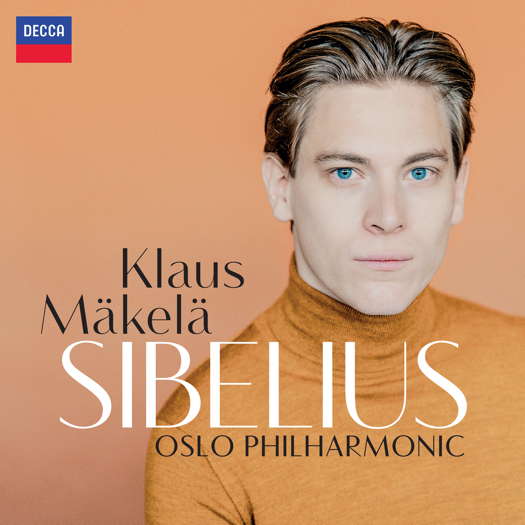 SPONSORED: Ensemble. Unjustly Neglected - In this specially extended feature, Armstrong Gibbs' re-discovered 'Passion according to St Luke' impresses Roderic Dunnett.
SPONSORED: Ensemble. Unjustly Neglected - In this specially extended feature, Armstrong Gibbs' re-discovered 'Passion according to St Luke' impresses Roderic Dunnett.
All sponsored features >>

A Marvellous Set
GEOFF PEARCE listens to the Sibelius symphonies, played by the Oslo Philharmonic and Klaus Mäkelä
'The Oslo Philharmonic responds magnificently to the direction and vision of Klaus Mäkelä.'
Sibelius has long been a favourite composer of mine and I was wondering what this new cycle would bring. Quite a lot, actually.
The First Symphony is, in my mind, somewhat under-appreciated. I have a few other recordings of it, and I've never tired of the work. This new recording is stunning in the explosive outbursts, changes of texture, fantastically controlled accelerandos, rapid changes of mood and orchestral colour, and delicate and detailed playing when the score calls for it. When there are grand pauses in the music, the silence is dramatic. The sense of story-telling is great in this symphony, and the attention to detail and clarity is outstanding. My only complaint, and it may be my sound system, is that whilst there is a lot of depth and detail in the recording, and there is not too much reverberation (one of my pet hates), at times it just feels too bright and edgy, but it does depend on one's own personal preference and what one is listening on.
Listen — Sibelius: Scherzo. Allegro (Symphony No 1)
(4852256 CD1 track 3, 1:48-2:48) ℗ 2022 Decca Classics :
The Second Symphony is an altogether warmer work and is one of the most known and popular (along with the Fifth Symphony). The playing is sumptuous, and every section excels in the warmth and beauty of sound and the details of the score are vividly brought to life. The sense of anticipation in the first movement is present at every turn, and the journey the composer is taking you on is logical and never forced. The same can be said for the climaxes. The rather mysterious and brooding second movement is atmospheric and one of the most compelling performances I have heard. When the tension rises, it is beautifully judged and never overcooked. The serene moments are not overdone either, and it does not bog down or become mushy. I think the second movement is the emotional core of this work.
Listen — Sibelius: Tempo andante, ma rubato (Symphony No 2)
(4852256 CD1 track 6, 3:01-3:45) ℗ 2022 Decca Classics :
The third movement starts off very fast and dramatically, then with a beautifully lyrical middle section before it explodes again. This is a very exciting performance.
Listen — Sibelius: Vivacissimo (Symphony No 2)
(4852256 CD1 track 7, 0:00-0:54) ℗ 2022 Decca Classics :
The last movement has grand gestures and rapid changes in dynamics and textures, and again the fine details of this recording are exemplary, and at no stage does it suffer from the brightness that detracts from my enjoyment of the first symphony.
The Third Symphony is my favourite, and perhaps it is not performed quite so often, which is a pity. It starts happily, but there are twinges of sadness that come out from time to time. This does not last. There are, again, many moments of contrast, the transitions are well managed and again the director really seems to know the score intimately. The second movement is sad and nostalgic, and has some difficult writing for the woodwind, who often work in pairs. This is probably the finest recording I have heard of this movement, especially in middle section.
Listen — Sibelius: Andantino con moto, quasi allegretto (Symphony No 3)
(4852256 CD2 track 2, 6:54-7:44) ℗ 2022 Decca Classics :
The last movement is full of contrast, at times jocular, and at others quite driven and spine chilling. The easy virtuosity of the players is a delight and offers a very thrilling performance.
The Fourth Symphony is a sombre and brooding work. I find it sorrowful and intense. The atmosphere is realised very well, as is the drama in the first movement. Whilst there are tender and warmer sections here, the darkness is never fully dispelled, but the movement does end on a more hopeful note.
Listen — Sibelius: Tempo molto moderato, quasi adagio (Symphony No 4)
(4852256 CD2 track 4, 6:06-6:50) ℗ 2022 Decca Classics :
The second movement begins as a dance movement in character, but it is shot with darkness and drama, and there are frequent changes of mood. The third movement has a remoteness and distance, and again this is beautifully captured. There are some grand climaxes too, and these are thrilling. The last movement is somewhat livelier and generally the mood is more upbeat and dispels the gloom present in the previous movements.
The Fifth Symphony is probably the most popular with orchestral goers, along with the second, and there are many excellent recordings available. The opening movement has a lot of contrast, but intonation problems are very often a feature in many of the recordings I have heard, particularly in the very opening between brass and woodwind. This does not occur in this performance, and overall intonation in this set is exemplary. The sense of anticipation and the tension and release make this truly one of the best recordings I have ever heard. The second movement also has areas that can come unstuck with intonation, especially between flute, plucked strings and a low pair of oboes which later play a higher version of their tune as the movement progresses. In many otherwise good performances this can sound very sour, but not here.
Listen — Sibelius: Andante mosso, quasi allegretto (Symphony No 5)
(4852256 CD3 track 2, 0:23-1:16) ℗ 2022 Decca Classics :
The last movement has a great performance, with the build up over a long period, held beautifully in check so that the climax of the piece does not happen too early.
I love the Sixth Symphony. There is a clarity and sadness in it. Sibelius took quite a long time to write it, and called it 'cold spring water'. I think this is more to do with the clarity of the textures and clean instrumentation. There are few strong climaxes or emotional outbursts. The sadness does not overwhelm, and I think overall the feeling is quietly optimistic. The third movement, quite joyous, has two climaxes, one in the middle, mirrored by one at the very end. The last movement has a long-restrained introduction before the movement really picks up pace and becomes quite fiery and dramatic. This is the music of fire and ice, and quite a saga, very different from the preceding movements.
Listen — Sibelius: Allegro molto (Symphony No 6)
(4852256 CD3 track 7, 4:11-5:00) ℗ 2022 Decca Classics :
The mood does not last, however, and all of the energy is soon dissipated over the second half of the movement, which ends in a whisper.
The Seventh is Sibelius' final symphony, even though he lived another thirty years. (He is believed to have started an eighth, but burned it before completion.) It is really a single-movement work, but is here is divided into four tracks. I do not know why this has been done as, in my mind, it makes more sense to record it as the composer intended, particularly as the endings of each section are abrupt. Evidently a lot of the material in this work incorporates music from an abandoned symphonic poem, Kuutar (Moon Spiritess). Some of the material from this work is also found within the fifth and sixth symphonies. Of all the symphonies, I find this final one to be more like a large symphonic poem in nature.
Listen — Sibelius: Allegro molto moderato (Symphony No 7)
(4852256 CD4 track 3, 1:58-2:38) ℗ 2022 Decca Classics :
Tapiola is Sibelius' last important work, and is technically close to the Seventh Symphony. Here it receives a very satisfying performance. The changes in mood and colour are vividly represented.
Listen — Sibelius: Tapiola
(4852256 CD4 track 5, 12:11-12:56) ℗ 2022 Decca Classics :
This is followed by three fragments, one about two minutes long, another just over a minute and a half and the other less than thirty seconds. I am not sure why they were added, as the disc comes without a comprehensive booklet.
This is a fantastic set for anyone wanting the complete Sibelius symphonies. I have various recordings of individual symphonies and one complete cycle, but this stands equal to or surpasses the best of them. The Oslo Philharmonic responds magnificently to the direction and vision of Klaus Mäkelä. His attention to scoring details and the amazing use of silence when required continue to entrance me, even on multiple hearings. My only reservations would be that in the First Symphony, I find the recording level overly bright and tiring at a couple of places, and that the last symphony was artificially divided into four tracks, which I think detracts from the whole. Apart from those minor quibbles, this is a marvellous set that would take pride in anyone's collection.
Copyright © 9 March 2022
Geoff Pearce,
Sydney, Australia

CD INFORMATION: SIBELIUS - OSLO PHILHARMONIC / KLAUS MÄKELÄ
CLASSICAL MUSIC ARTICLES ABOUT FINLAND



